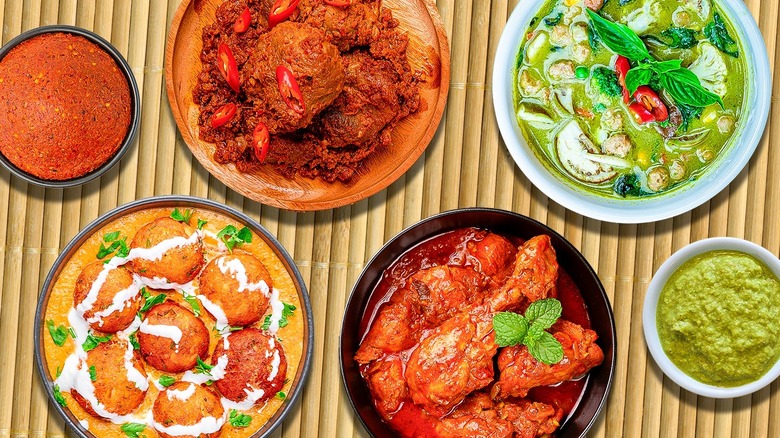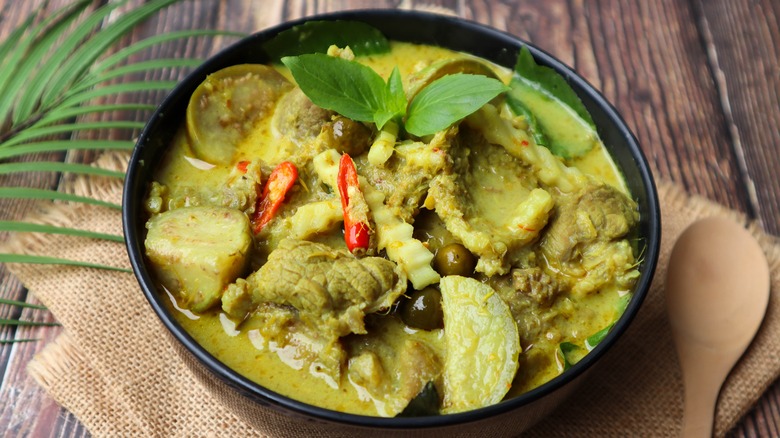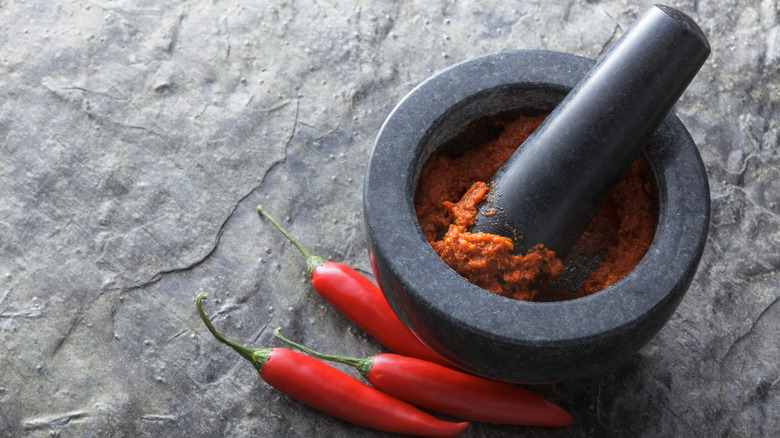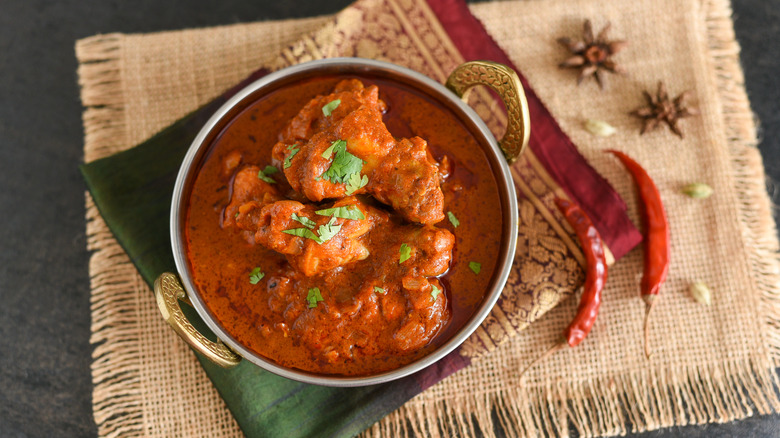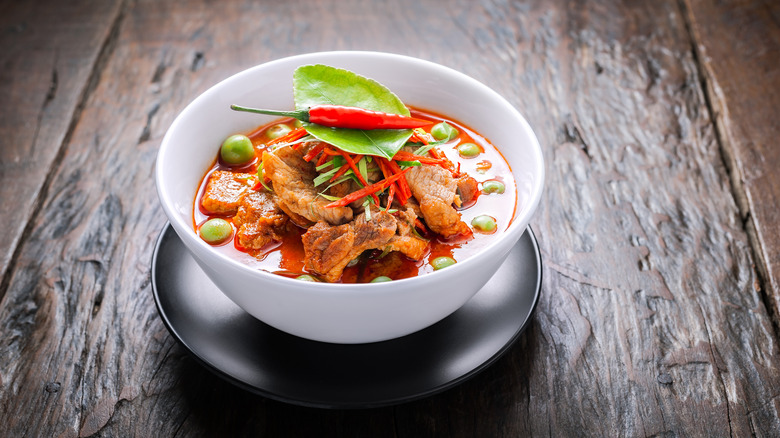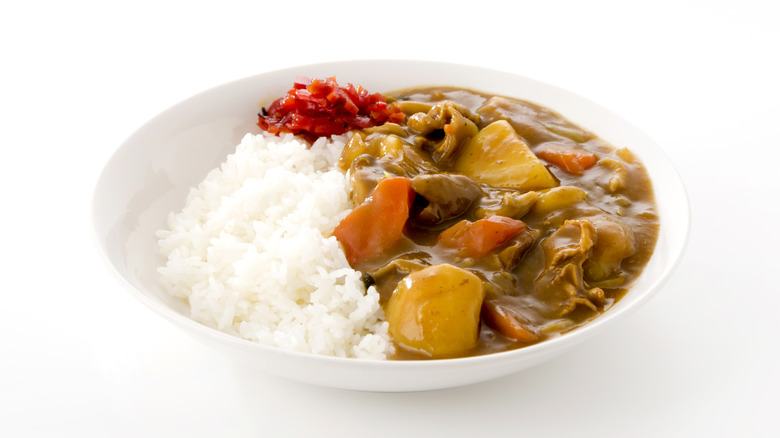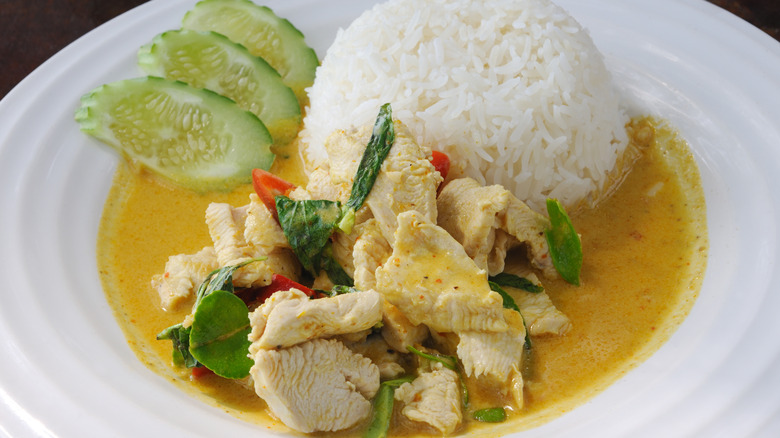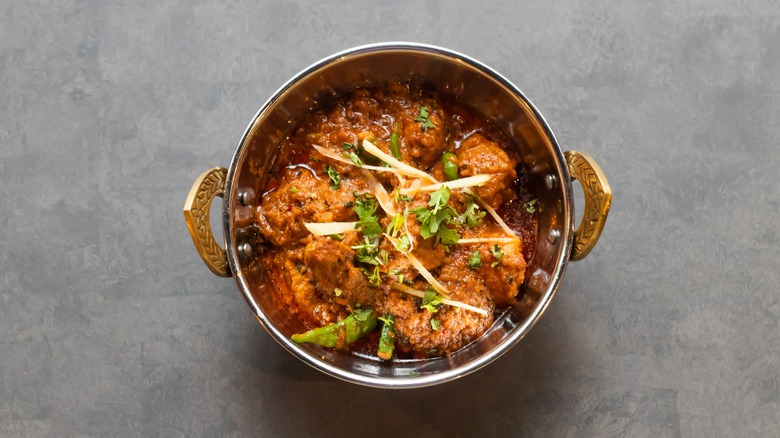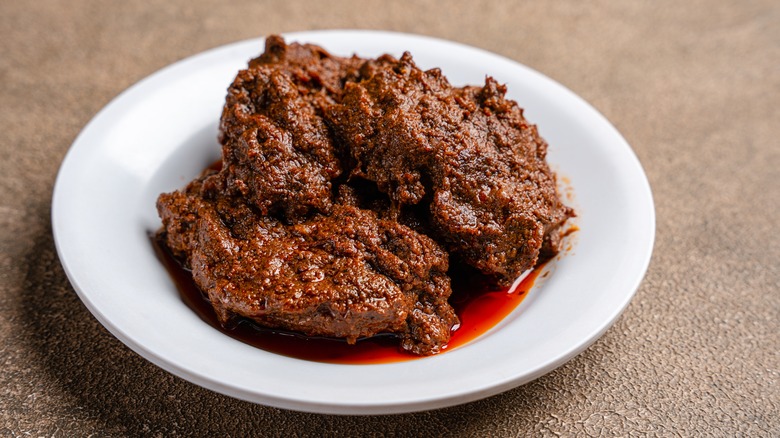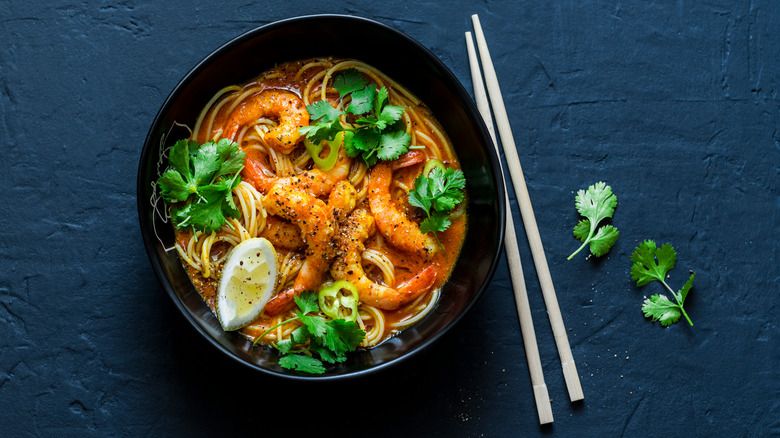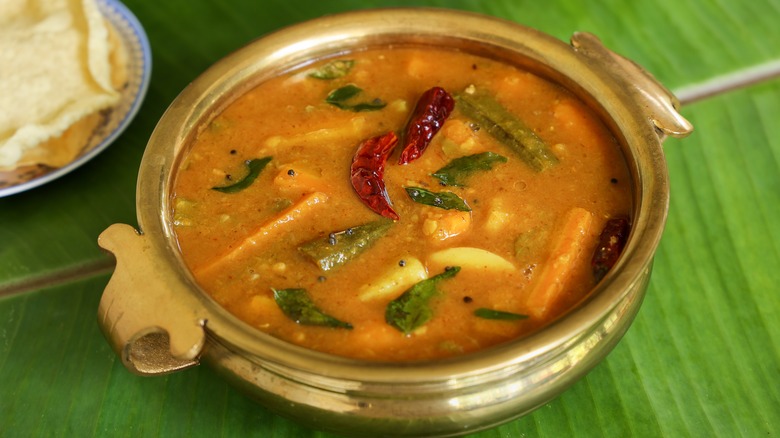12 Types Of Curry Pastes And How To Use Them
It's easy to be intimidated by a plate of curry. Perfectly balanced spices in a sauce coating tender meat atop a puffy hill of white rice can seem more like magic than cooking, but if you can get the hang of curry paste, this dream can be yours. A self-proclaimed curry aficionado, the scent of curry is practically infused in the walls of my kitchen.
Curries are typically found in Asian cuisines and come in a wide variety of flavors and styles that can range from intensely thick, spicy, and meaty to sweet, soupy, and full of seafood. But most curries have one thing in common: They start with a paste. Curry paste is a concentrated mixture of aromatics, herbs, and spices that forms the base of any curry, and making a great curry is all about knowing how to use the paste. While you can always make your own fresh curry paste, for most curries, the paste is available in grocery stores.
You should always keep curry paste in your pantry because it's a super versatile ingredient that is easy to use once you get the hang of it. To level up your curry game, read on to find out about different types of curry and how to use them in your kitchen.
Green curry paste
Of all the curries on this list, Thai green curry may just be the most widely beloved. This dish is available at most Thai restaurants, where most curry connoisseurs have had their fill of the slightly spicy, coconutty concoction, but if you have green curry paste, it's super simple to make at home. Green curry paste contains ginger, galangal, cumin, coriander, and makrut lime leaves, which is the ingredient that gives this paste its attractive green hue.
One of the keys to using green curry paste is to fry it off before you start adding other ingredients, which releases the fragrance of the paste ingredients, a process akin to sautéing garlic and heating spices. Take a scoop of the paste (either store-bought or homemade) plop it into a pan and keep stirring it over the heat so that it doesn't burn. After that, add coconut milk, enough to give the curry an almost soupy consistency (green curry should be thinner than red curry, and much thinner than panang). Green curry has a salty, slightly spicy, and very faintly sweet flavor profile that pairs perfectly with soft Japanese eggplant and crunchy snow peas. You can add any protein you'd like, or even tofu if you're a vegetarian.
Massaman curry paste
For a super hearty curry that's full of warming spices and hearty ingredients, get your hands on some Massaman curry paste. Massaman curry is from Southern Thailand, where the local cuisine is influenced by its Malaysian neighbor and also has flavors from the Indian subcontinent. If you live near an Asian grocery store, you can probably find Massaman curry paste in a can or jar, or you can make it yourself with cloves, cardamom, cinnamon, nutmeg, and cumin, in addition to the other classic curry paste ingredients like ginger and garlic.
Massaman typically isn't as spicy as other Thai curries, but If you're hankering for something hot, you can opt to add some Thai chilies when your paste hits the pan or some sriracha at the end of the cooking process to fine-tune the spice level. Mix the sizzling curry paste with coconut milk (full fat) and cook it down until it becomes nice and thick. Once you're happy with the consistency, serve with onions, potatoes, peanuts, and your choice of protein (although we recommend beef because it's a hearty pal to the potatoes). You can even plate it up with some creamy avocado as a garnish, which goes well with the muted yellow color of the curry and tastes creamy and fresh.
Red curry paste
If you like the fiery intensity of Thai food, then perhaps you're a fan of Thai red curry. Red curry paste combines some of the best flavors that the cuisine has to offer: the freshness of lemongrass, the warmth of ginger, the funk of fermented shrimp paste, and the heat of dried red chili peppers, which also give red curry paste its appetizing pink color. You can make it at home (traditionally, the ingredients are crushed in a mortar and pestle, but you can use a food processor), or you can buy it at the store (we recommend Maesri brand curry paste if you go this route, which you can find at some specialty grocery stores or on Amazon).
The base of red curry is coconut milk, which you mix into the red curry paste in a pan, and it's of the utmost importance that you use full-fat coconut milk to make the curry rich and creamy. When it comes to vegetable pairings (every curry has its preferred veggies), bamboo shoots, zucchini, and winter melon are all good options, and if you like a bit of sweetness in your curry, pineapple adds a nice contrast to the intense, spicy curry flavor. In terms of proteins, red curry is one of the most versatile on the list, and you can use just about any protein you have on hand, although we prefer this Thai red curry chicken recipe.
Vindaloo curry paste
For an Indian curry that packs a serious punch, find a jar of vindaloo curry paste. Cinnamon, paprika, and cumin are mixed with a generous portion of crushed Kashmiri chilies to give this curry paste the notoriously spicy reputation that it deserves. You should fry up your vindaloo paste before you add other ingredients and if you're looking for even more spice, heat up some more Kashmiri peppers during this step and mix them with the paste.
Next, thin the paste out with an Indian curry base, which is what they use at Indian restaurants in practically every curry. Recipes for Indian curry bases vary, but they generally contain onions, garlic, ginger, tomato, herbs, and spices. Also, stir in some tangy tamarind paste and a bit of sugar to balance out all the bold flavors, and then let the mixture simmer until the flavors meld together. Again, this is one of the spicier curries on the list, so you might want to have some cooling raita on hand when you serve it up.
Panang curry paste
Just the sound of the word "panang" is enough to start your salivary glands. This thick, rich, nutty curry graces the menus of most Thai restaurants in the United States, so if you're a fan of Thai food, you've probably heard of it. Although panang shares the same pale red hue as red curry, there's a difference between these two spicy sauces, and it's in the paste.
Panang curry paste is made with crushed peanuts, which gives it a slightly oily nuttiness that sets it apart from its red cousin. Like other Thai curry preparations, you want to heat the curry paste in the pan before you add the coconut oil, which forms the liquid part of the curry. Panang is meant to be thicker and richer than other Thai curries (it's also typically served with a higher meat-to-curry ratio), so it doesn't call for broth to thin it out. To transform red curry paste into panang curry paste, all you need to do is add crushed peanuts, cumin, and coriander, and the rest is in the cooking method. Any protein goes with this spicy, nutty paste, but there's something about the richness of a beef panang curry that's extra special.
Japanese curry roux
Curry may not be the first dish you think of when you think of Japanese food, but if you've never had Japanese curry, you're missing out. Especially because it's super easy to make at home if you get some Japanese curry roux (which is the equivalent of paste, just a bit more solid). With most of the other curries on this list, you cook the meat in the curry paste, but with Japanese curry, it's the opposite.
Start out with some fresh onions, garlic, and ginger, and then add your meat and cook it until it's browned. Next, add water and when it comes to a boil, add veggies. Japanese curry is a hearty dish and is typically made with root vegetables like carrots and potatoes, which are cooked through with the meat until soft. Only now do you add the curry roux, which comes in little blocks that can be broken up and mixed with the liquid until it all turns a rich brown color. Alternatively, you can fry the meat separately and add it at the end. Simmer it until it has a thick consistency and serve on top of rice. You can buy Japanese curry packets in most Asian grocery stores or online.
Yellow curry paste
If you love the complex taste of curry, but can't handle the spice of most types of Thai curry, then you should get your hands on some yellow curry paste, which is a version that's not as commonly available at Thai restaurants in the United States and is often prepared to taste milder than other curry pastes. Yellow curry paste is made of lemongrass, ginger, garlic, fenugreek, and, of course, turmeric, which gives this tasty curry its intense yellow glow (but be careful because turmeric stains absolutely everything).
Yellow curry paste isn't as easy to find at grocery stores, so you're better off making your own, which you fry in a pan until fragrant and then add chicken stock and stir until you have a soupy consistency. When you're using yellow curry paste, we recommend you go for coconut cream instead of coconut milk, which will give this curry a characteristically thick consistency (thicker than red and green curries). The ingredient conspicuously missing from yellow curry is a squeeze of lime, which doesn't go with the warming vibe of this rich, intense curry. As far as vegetables, potatoes, and carrots go perfectly with yellow curry for a hearty winter meal.
Korma curry paste
If you're in the mood for an Indian curry that delivers all the richness and flavor that the subcontinent has to offer without the spiciness that comes standard in many Indian curries, then korma might just be the curry for you. While korma paste shares many ingredients with other Indian curries like cumin, coriander, and garam masala, what sets this creamy curry apart is the inclusion of coconut and cashews, which give it an opaque light yellow color and a rich, nutty flavor.
Once you've got your korma paste, fry up some onions and mix in the korma curry paste before cooking the meat in the mixture. Next comes the coconut milk. Although coconut milk is more common in Thai curries than in Indian curries, you'll find that it goes perfectly with korma's subtly sweet flavor. Right before you serve it up, add a few tablespoons of yogurt to give the dish a bit of tartness to balance out the sweet coconut milk. Korma is typically garnished with blanched almonds and a bit of cilantro and enjoyed with naan and basmati rice. You can use any kind of meat, but a creamy and fragrant chicken korma is one of our favorites.
Burmese curry paste
While Burmese food doesn't quite have the global presence enjoyed by its Thai or Indian neighbors, this Southeast Asian country has a robust curry culture and a curry paste to match. Like many Indian curries, Burmese curry is tomato-based and flavored with turmeric and ginger, but like many Thai curries, it also carries the taste of lemongrass and fish sauce. Burmese curry varies depending on the region of the country, but typically the paste contains ginger, garlic, coriander, turmeric, and just a hint of brown sugar to round it out with a bit of sweetness.
Burmese curry paste can be mixed with fish sauce and stirred in with the raw meat of your choice (chicken is a popular option). Once you've got it well coated with all the flavorful curry paste, you can add water and coconut cream and simmer the mixture until the meat is cooked through. Typically, Burmese curry is served with fried shallots on top of a heaping mound of coconut rice.
Rendang curry paste
While you might imagine that curry is always a saucy affair, there are some curries out there known as "dry curries" that are typically meat coated with minimal sauce and served up with rice. But a sauce does not a curry a maketh. Rendang curry, which hails from the Indonesian island of Sumatra, is an example of a dry curry that packs a huge amount of flavor with just a bit of sauce. But even dry curries start out with a curry paste, and rendang is no exception.
Like many Thai curries, the base of rendang curry paste is a mixture of lemongrass, galangal, garlic, and ginger, although this Indonesian variety also includes cloves, cinnamon, and star anise, which give rendang a deep, warm flavor, and chiles, which give it a healthy kick. Once you heat up the paste, mix in beef or chicken, which are the preferred meats for this particular curry. Dilute the paste mixture with beef stock and coconut milk and be sure to give the curry enough time (about two hours) to simmer down to a thick sauce that clings to the meat for a super tender beef rendang before serving over a steaming pile of coconut rice.
Laksa curry paste
Malaysia may not have as robust a culinary reach as its northern neighbor, Thailand, but Malaysian laksa curry, one of the country's most famous dishes, is a tangy, brothy flavor sensation that will leave you wanting more. In terms of consistency, laksa is on the opposite end of the spectrum from dry curries like panang and rendang. The paste is diluted with broth until it almost resembles soup more than a traditional curry.
Laksa paste contains many of the classic Southeast Asian ingredients that are present in Thai curries like lemongrass, Kaffir lime, galangal, and turmeric, although laksa also contains some crushed nuts, which give it an extra creaminess that makes the soup taste more rich. After sauteing the paste in some oil until fragrant, add chicken broth until the curry paste has been diluted, along with a bit of sugar and lime leaves some sweetness and tanginess. Cook the meat (typically chicken and shrimp) in the broth and then add coconut milk and simmer until the mixture is heated through. Instead of serving with rice, like most curries, laksa is served with noodles and a squeeze of fresh lime juice.
Sri Lankan curry paste
Rich, spicy curries are the name of the game in Sri Lanka, an island country off the southern coast of India. A unique blend of influences from Southeast Asia, India, and Europe gave this island nation a rich cultural legacy that is found in its cuisine, particularly its curries. While different regions of Sri Lanka have different recipes for curry paste, Sri Lankan curries are typically made with ginger, tamarind paste, curry leaves, and pandan leaf, which tastes like an earthy version of vanilla.
Sri Lankan curry paste is typically fried up and mixed with coconut milk to dilute it and add creaminess and a bit of sweetness to the preparation. Coconut milk also gives you the saucy consistency typical of Indian curries. It can be made with any kind of meat, and chicken is a common choice, and its also made with vegetables and there's even a Sri Lankan-inspired green apple curry that'll challenge your concept of what curry is. Sri Lankan curry paste is very aromatic and can also be mixed with yogurt and used to marinate meat for a rich, hearty, spicy flavor.
